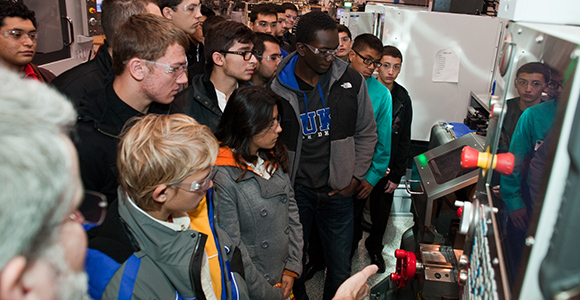
(Photo Credit: COD Newsroom/Flickr)
The problem is obvious: The California economy needs one million more middle-skill workers trained to fill jobs opening up the next 10 years. Yet employers are having a hard time finding enough qualified workers now.
That’s why supporters of career technical education gathered in Sacramento Tuesday to support two proposals that will generate nearly a quarter of a billion dollars for workforce development in California. The Assembly Budget Subcommittee heard testimony on a $200-million investment for the Strong Workforce Program as well as the $48-million annual commitment to the Career Technical Education Pathways Program outlined in the Governor’s proposed January Budget.
It’s not surprising that the California Economic Summit is involved in the issue. The Summit aims to increase opportunity by providing California’s workforce – and its businesses and entrepreneurs – with the skills, knowledge, and abilities they need to fill well-paying jobs in changing markets.
Representing the Summit, Justin Ewers, deputy director for California Forward’s Partnership for Economic Prosperity, told legislators that these two workforce-training investments are a vital first step to implementing the California Community College Workforce Task Force Recommendations adopted by the Board of Governors.
“They will bolster a new wave of career technical education programs that have a track record of producing workers who earn salaries nearly twice as high as typical community college graduates,” Ewers said to legislators. “They will help regions begin to close the growing ‘skills gap’ projected to prevent as many as a million Californians from moving up into the middle class over the next decade.”
Ewers added that if these funds are allocated across regional economies and industry clusters—instead of simply distributed to all community colleges—they can serve as a critical fiscal incentive, encouraging colleges to work together across regions to determine how these dollars are spent and to efficiently tailor programs to better meet the needs of local employers.
In addition to supporting regional economies, legislators heard from faculty members, advocates for developing more STEM (Science, Technology, Engineering, Mathematics) economies and examples of regional collaboration that has already started in California.
Among those also testifying were Marty Khatib from Dignity Health, a major California healthcare employer, Laurie Harris of the California Council on Science and Technology, Rock Pfotenhauer, Bay Area Regional Consortia chair and Steve Glyer, Los Angeles – Orange County Regional Consortia co-chair.
“The $200 million signals the support of the Governor and the Legislature for the importance of career technical education and that policymakers value economic mobility for all,” said Van Ton-Quinlivan, vice chancellor of Workforce & Economic Development, California Community Colleges.
The Summit recently reported on a regional program in Southern California that is targeting the HVAC industry (heating, ventilation and air conditioning), which needs hundreds of qualified workers every year. Programs like this are expected to expand if the funding is approved.
The California Economic Summit has been concentrating on the workforce problem since the Summit began five years ago. The Summit’s Workforce Action Team has been working on preparing people for in-demand jobs in high-growth industry sectors, prioritizing workforce-training resources for major regional industries, and creating partnerships between local workforce-investment boards (WIBs), community colleges, economic-development organizations, businesses, and labor.
A similar hearing on CTE funding will be held in Sacramento on April 7 by a Senate subcommittee.

